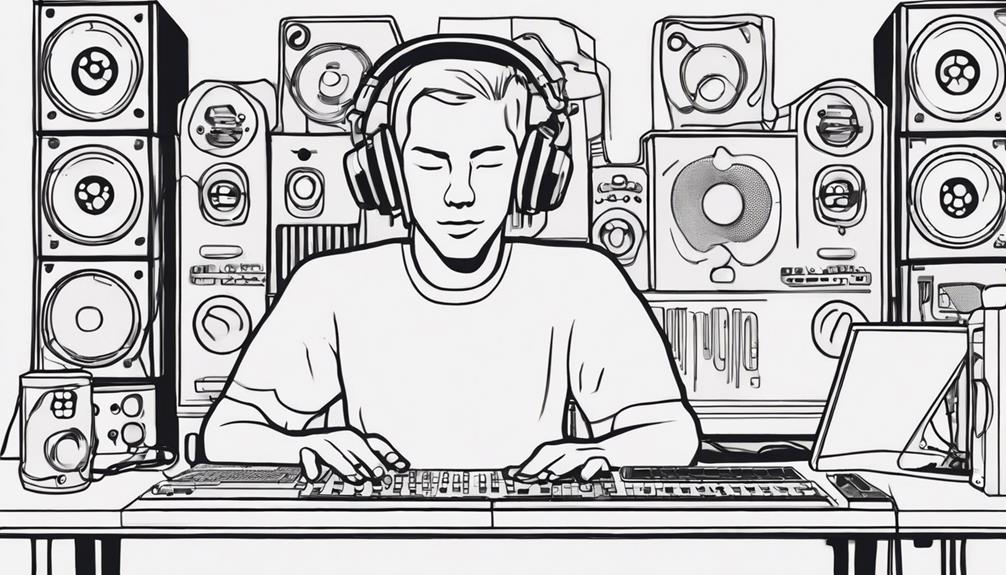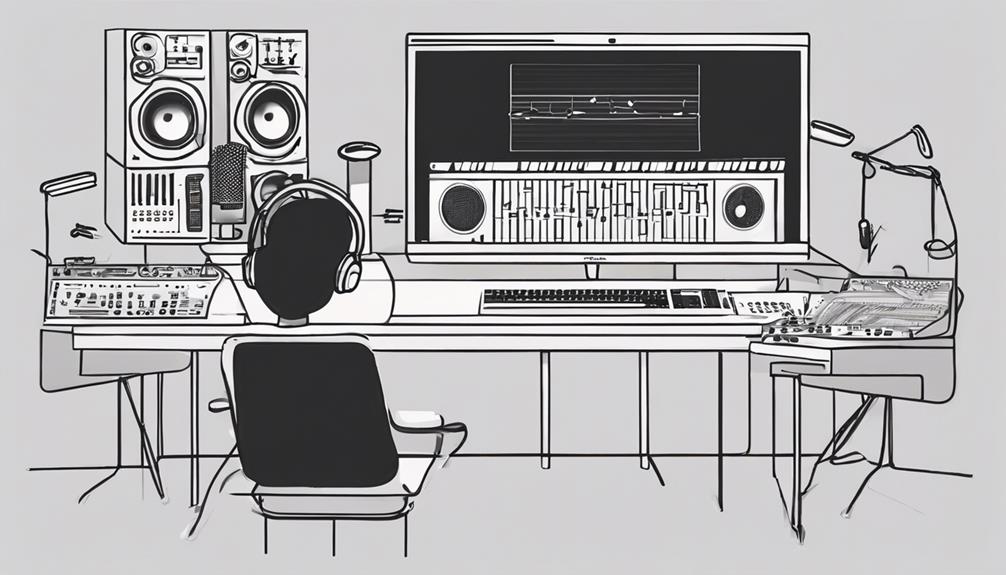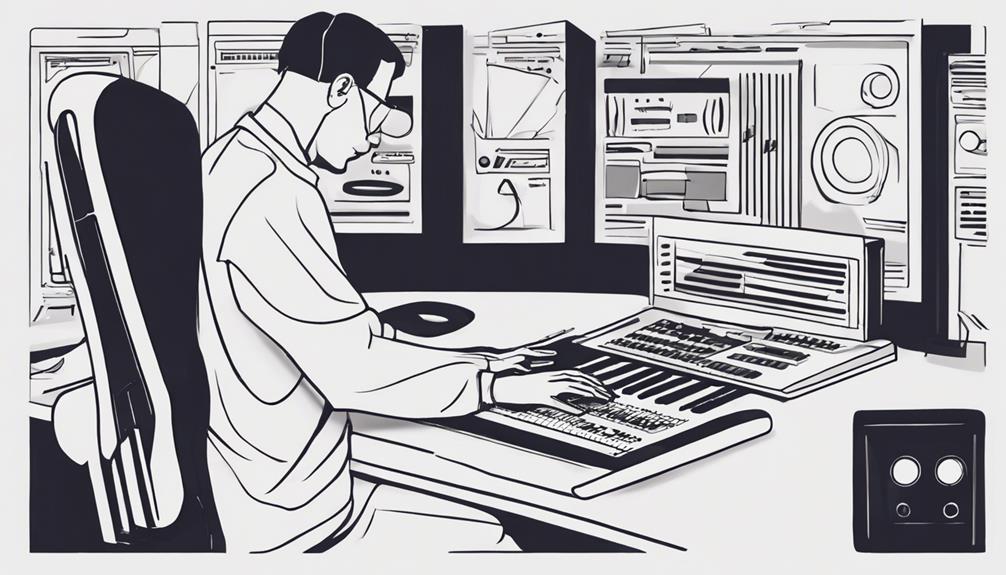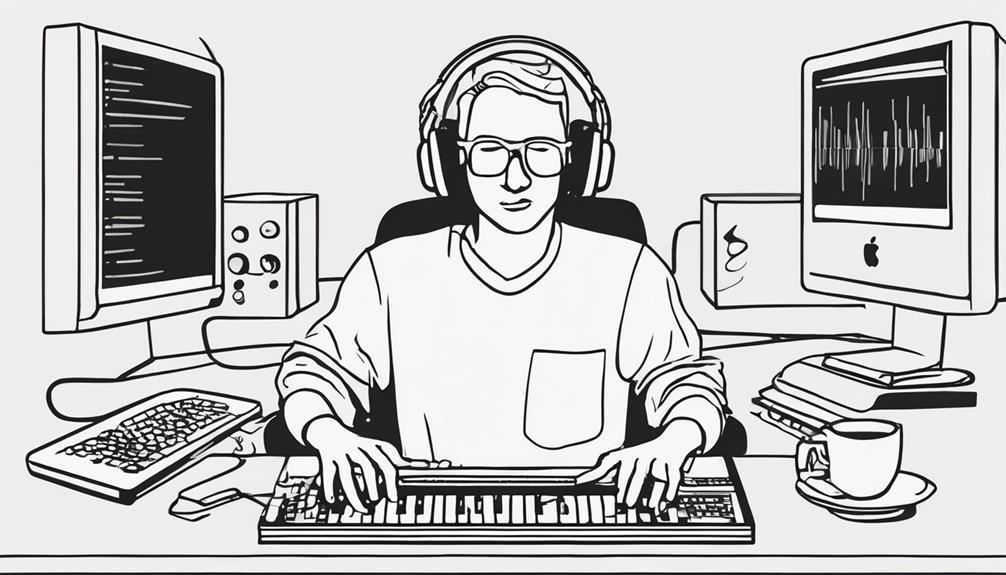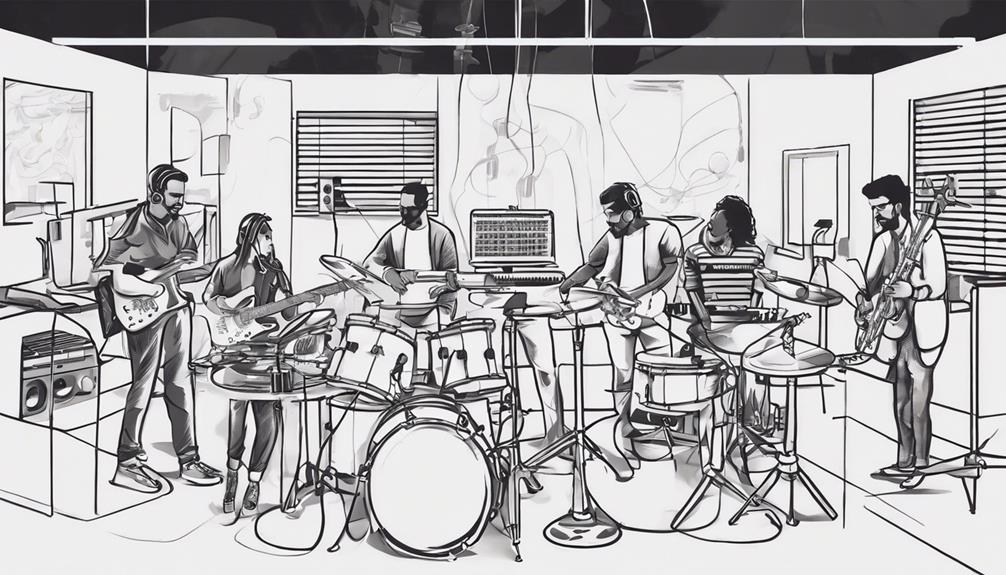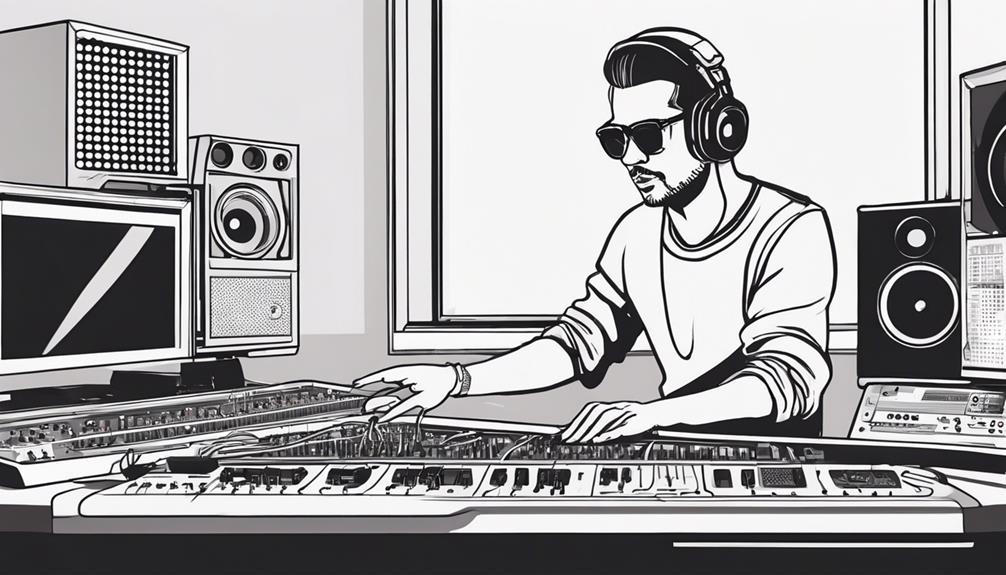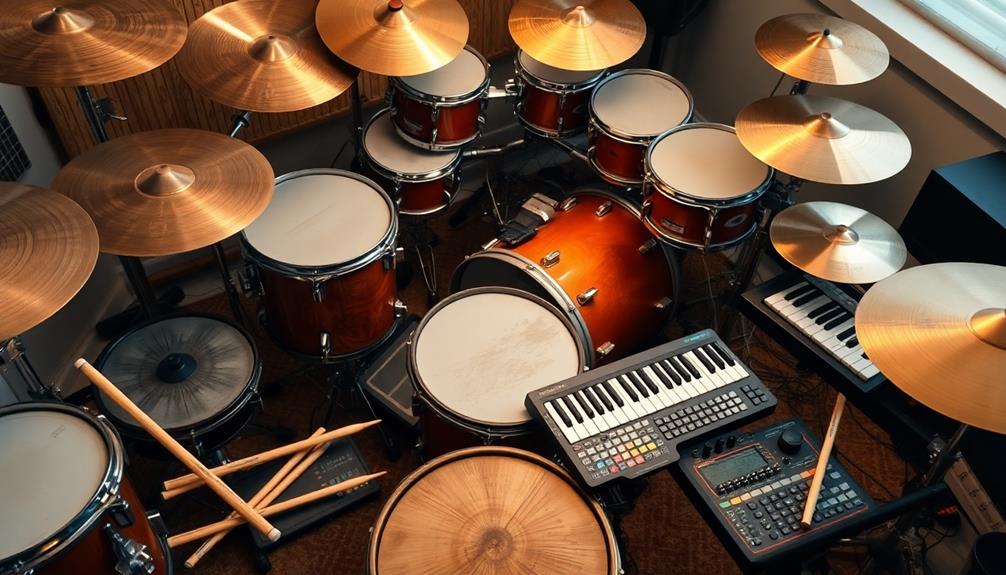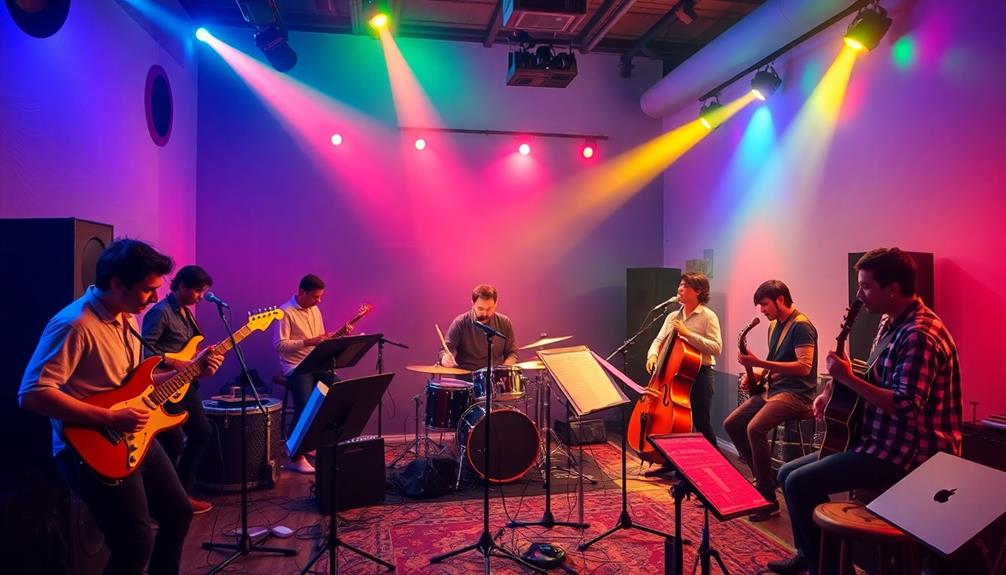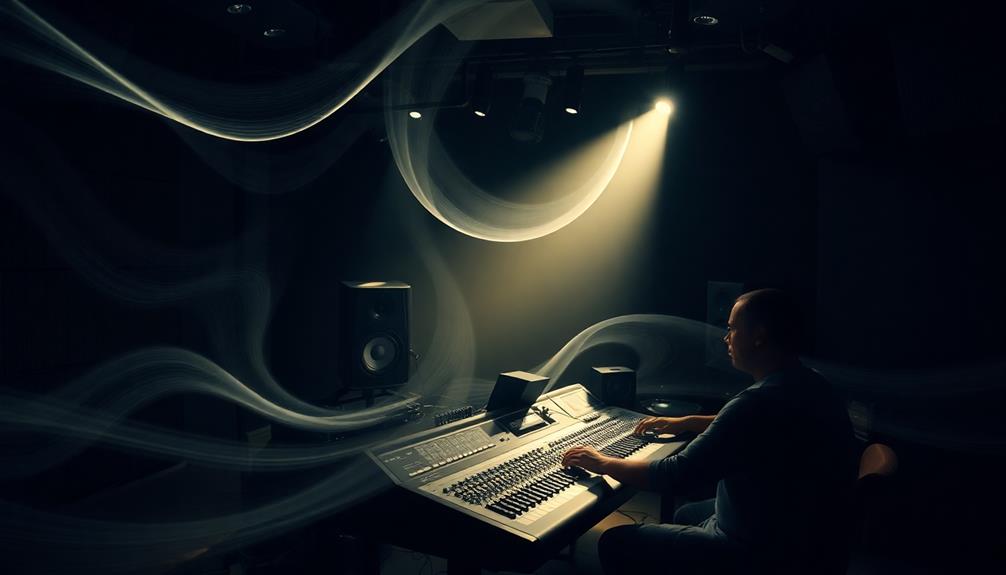Teach music production by covering music theory basics, such as notes forming scales and scales building chords. Demonstrate production techniques like EQ, compression, and reverb. Integrate software that aligns with your teaching style and curriculum objectives. Encourage students to experiment with new genres and instruments in a creative environment. Learn mixing and mastering essentials for sound quality. Explore various music industry careers and stress the importance of business fundamentals. Equip aspiring producers with a well-rounded understanding of the field. Further insights await as you continue discovering effective ways to educate in music production.
Key Takeaways
- Incorporate hands-on projects for practical application.
- Encourage creativity and experimentation in student projects.
- Provide resources for software selection and integration.
- Teach fundamentals like EQ, compression, and mixing techniques.
- Discuss music industry careers and business fundamentals.
Teaching Music Theory Fundamentals
Teach music theory fundamentals consistently to help students grasp the essential building blocks of music production.
Understanding music theory is vital for aspiring music producers. Start by explaining the basics of music theory, such as notes, scales, and chords. Break down how these elements work together to create harmonious compositions.
Show students how notes form scales, and scales build chords, illustrating the interconnected nature of music theory.
Utilize examples and exercises to reinforce these concepts. Encourage students to practice applying music theory fundamentals in their own compositions.
Emphasize how a strong foundation in music theory influences melody, harmony, and overall structure in music production. By mastering these fundamentals, students can enhance their composition skills and create more cohesive and engaging pieces.
Practical Music Production Techniques

Master practical music production techniques by exploring essential tools and methods that enhance sound quality and creativity in your productions.
In music production, EQ, compression, and reverb play pivotal roles in shaping the overall sound of a track. Teach students how to use EQ to adjust the frequency balance, compression to control dynamics, and reverb to add depth and ambience to their mixes.
Additionally, emphasize the importance of panning and spatial effects to create a wide and immersive soundstage. Show how to apply limiters and maximizers during mastering to guarantee ideal loudness levels without causing distortion.
Illustrate the use of automation to introduce dynamic changes and movement, enhancing the listening experience for the audience.
Lastly, stress the significance of proper gain staging and signal flow to maintain clarity and prevent audio clipping in production.
Software Selection and Integration
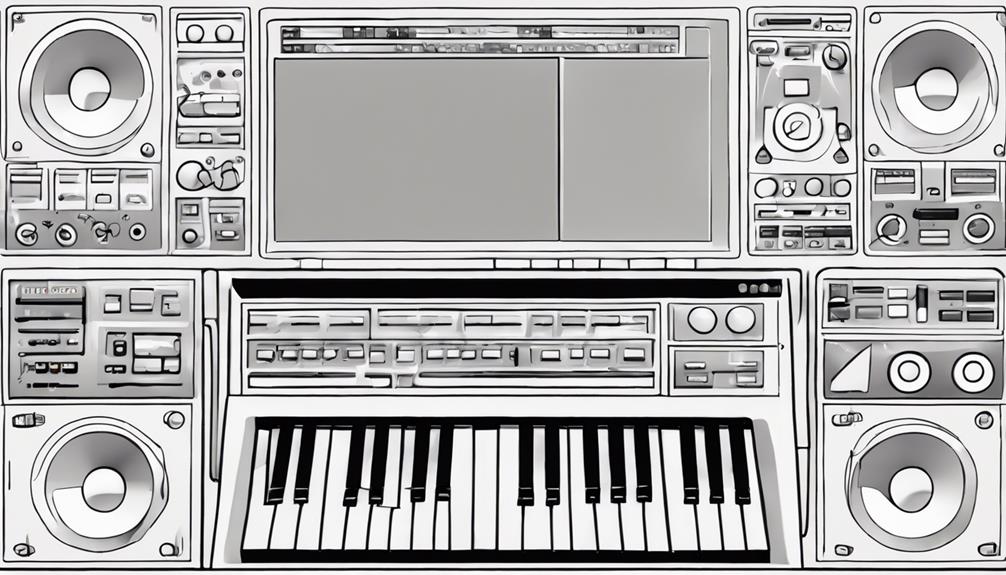
When selecting music production software for teaching, consider features, interface, compatibility, and cost.
Guarantee the software aligns with your teaching style and curriculum for effective integration.
Provide tutorials and resources to support student learning and understanding of the chosen software.
Choosing the Right Software
Consider evaluating software features such as MIDI support, virtual instruments, and effects when selecting the right software for music production. To make an informed decision, keep the following in mind:
- Compatibility: Guarantee the software works seamlessly across different operating systems to integrate into your teaching setup effectively.
- Cost Comparison: Compare the costs of various options, ranging from free software like GarageBand to premium choices such as Ableton Live, based on your budget and required features.
- Learning Resources: Provide students with tutorials and resources tailored to the selected software to aid in learning and practical application.
Seamless Software Integration
To seamlessly integrate software into your music production teaching, carefully select a program that aligns with your teaching style and curriculum objectives. Consider using a digital audio workstation (DAW) like Ableton Live or FL Studio, which offer a range of features, user-friendly interfaces, and compatibility with various systems.
Evaluate how the software can enhance your teaching style, whether you focus on hands-on projects, music theory applications, or a combination of both. Integrate the selected software into your curriculum by providing tutorials and resources for students to learn how to navigate and utilize its tools effectively.
Make sure that the software allows for practical demonstrations of music theory concepts such as scales, chords, and composition techniques, enabling students to apply theoretical knowledge in real-time music creation projects. By aligning your software selection with your teaching approach and curriculum goals, you can create a seamless integration that enhances the learning experience for your students.
Workflow Optimization Tips
Evaluate software features, interface usability, compatibility, and cost to optimize your music production workflow effectively.
When selecting software for your teaching style, consider how it aligns with your curriculum and enhances student learning. Providing tutorials and resources that cater to the chosen software can assist students in mastering its usage.
To streamline your workflow and guarantee seamless integration, here are some tips:
- Customize Settings: Tailor the software to your specific needs and preferences to work more efficiently.
- Utilize Keyboard Shortcuts: Learn and implement shortcuts to navigate the software more quickly and perform tasks efficiently.
- Integrate Third-Party Plugins: Enhance the software's capabilities by incorporating plugins that complement your production style.
Fostering Creativity and Experimentation
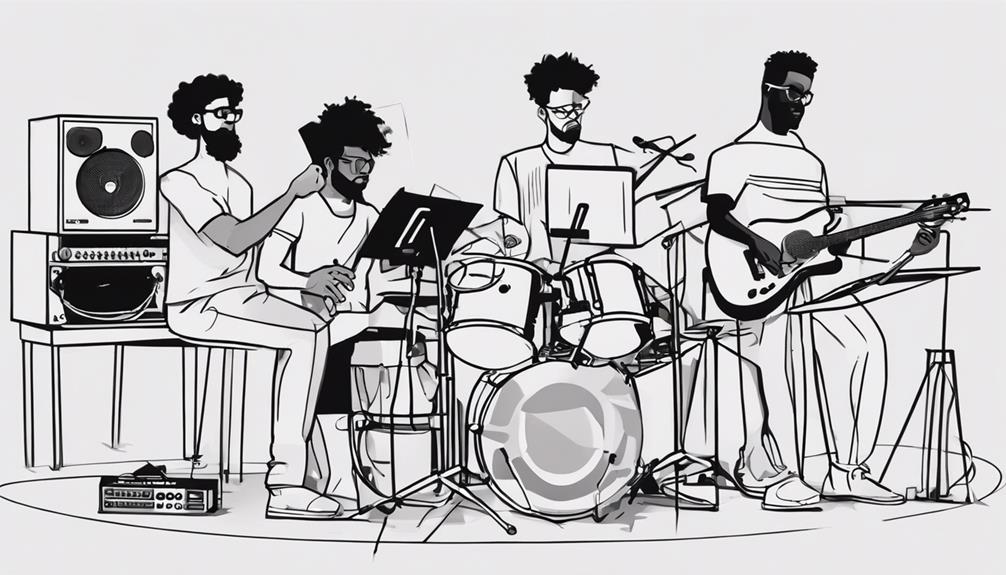
Encourage your students to explore new genres, instruments, and effects to find their unique sound.
Create a safe space for them to experiment with different techniques and tools.
Challenge them to think outside the box and push the boundaries of traditional music production.
Encouraging Creative Exploration
Foster a vibrant learning atmosphere that champions creative exploration and experimentation in music production. When teaching music production, it's essential to encourage students to create, innovate, and push boundaries. Here are some key strategies to inspire creative exploration:
- Supporting Curiosity: Encourage students to ask questions, explore new techniques, and investigate different genres to expand their musical horizons.
- Providing Guidance: Offer constructive feedback and mentorship to help students hone their creative skills and refine their artistic vision.
- Promoting Collaboration: Foster a sense of community where students can collaborate, share ideas, and learn from one another's unique perspectives.
Embracing Musical Experimentation
Embracing musical experimentation in music production involves encouraging you to explore a diverse range of instruments, sounds, and effects to stimulate creativity and innovation. By experimenting with different elements, you can uncover new ways of creating music and developing your unique sound.
Step out of your comfort zone and try fresh techniques to expand your skills and push the boundaries of what you can achieve in music production.
Creating a learning environment that supports experimentation is key. It allows you to discover your individual style and sound while fostering a culture of shared learning and innovation.
Collaborating with peers to exchange ideas and feedback can inspire you to embrace musical experimentation as a valuable tool for growth. Remember, guidance and inspiration are available to help you navigate this journey of exploration and discovery in your music production endeavors.
Cultivating Innovative Approaches
Cultivating innovative approaches in music production involves actively engaging with diverse genres, instruments, and techniques to nurture creativity and experimentation.
To foster a culture of innovation and creativity in music production, consider the following:
- Encourage students to explore a wide range of genres, instruments, and production techniques to broaden their creative horizons.
- Provide opportunities for hands-on experimentation with sound design, effects, and various production tools to inspire innovative approaches.
- Create a supportive learning environment that values originality and encourages students to take creative risks in their music production projects.
Mastering Mixing and Mastering Basics

You'll learn essential techniques for mastering mixing and mastering basics in music production.
Understanding the fundamentals of mixing, including EQ for balancing frequencies and compression to manage dynamics, is important. Compression helps create a consistent sound by controlling the volume levels of different elements in a mix.
Introducing mastering techniques like using a limiter to guarantee a balanced and loud final mix will elevate the overall quality of your productions.
Additionally, mastering the art of applying reverb and panning effectively can add spatial depth and width to your mixes, enhancing the overall listening experience.
Remember, critical listening skills play a crucial role in the mixing and mastering process. Training your ears to identify subtle nuances in sound will help you achieve a professional and polished sound in your music productions.
Practice these techniques diligently to master the art of mixing and mastering in music production.
Preparing for Music Industry Careers
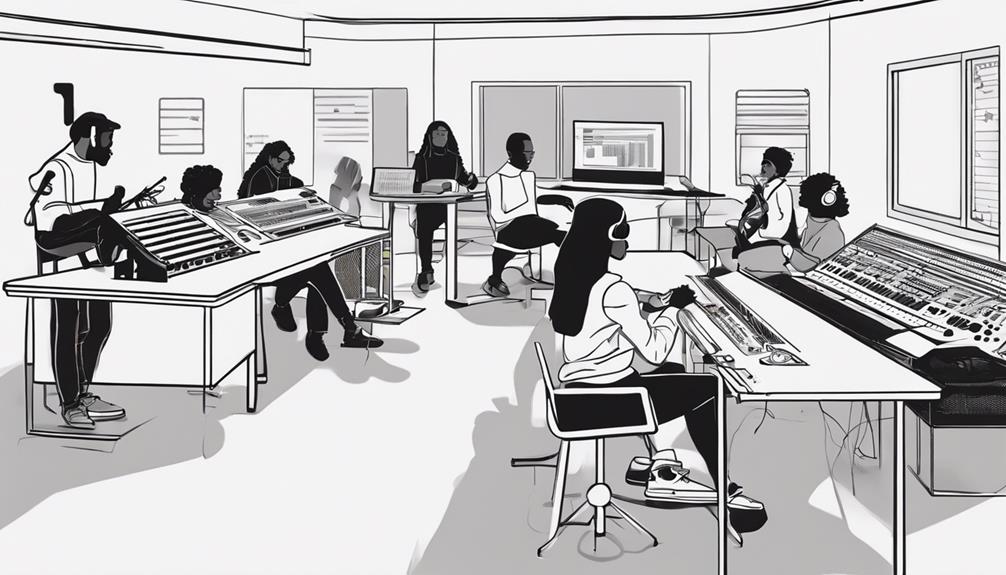
Understanding how music production education can lead to various career opportunities in the music industry is essential for aspiring music producers. As you start on your journey towards a music career, here are some key points to keep in mind:
- Diverse Career Paths:
Music production education opens doors to a range of career options such as sound engineering, music supervision, artist management, and more.
- Business Fundamentals:
Learning about copyright, licensing, distribution, and marketing is vital for maneuvering the complexities of the music industry and building a successful career.
- Industry Insights:
Educators provide valuable insights and real-world experiences that can help you make informed decisions and progress in your music career.
Frequently Asked Questions
How to Teach Someone Music Production?
To teach someone music production, start by introducing basic concepts like DAWs, MIDI controllers, and audio interfaces. Encourage hands-on learning with practical exercises, tutorials for software like Ableton Live, and emphasize integrating music theory.
How Do I Teach Myself Music Production?
To teach yourself music production, start by exploring free online resources, investing in essential equipment, experimenting with genres, joining communities, practicing regularly, setting goals, and staying open to learning. Your dedication will lead to progress. As you delve deeper into learning electronic music production, focus on understanding key concepts like sound design, mixing, and arranging. Take advantage of digital audio workstations (DAWs) and plugins to experiment with creating unique sounds and textures. Remember, growth comes from both perseverance and a willingness to step outside your comfort zone.
What Knowledge Does a Music Producer Need?
To succeed as a music producer, you need a strong foundation in music theory, composition, arrangement, and sound design. Understanding DAWs, MIDI controllers, mixing, mastering techniques, and the music industry is vital. Communication, collaboration, and problem-solving skills are essential.
What Is the Best Way to Learn Audio Production?
To learn audio production effectively, explore online tutorials, try various DAWs, engage in music forums, and attend industry workshops. Practice consistently by creating music and experimenting with sound. This hands-on approach will enhance your skills.
Conclusion
Share your love of music production with others by teaching them the fundamentals, techniques, and software needed to succeed in the industry.
Help aspiring musicians tap into their creativity and experiment with new sounds.
Guide them in mastering mixing and mastering basics to create professional-quality tracks.
Prepare them for exciting careers in the music industry.
Let your knowledge be the key to igniting their potential and passion for music production.
Join the journey of musical discovery together!

